|
Relating to The Earl E. Myers Story Chapter 19 — Assignment To 31st SRS, Okinawa |
|||||||||||||||||||
| In October 1949, with orders in hand, I packed up and began the process of getting myself over to the 31st SRS, Kadena AB, Okinawa. This was yet another new chapter in my life adventure as a career officer in the USAF. Life was good, I felt ready for whatever may lay ahead. Little did I realize that there was more excitment and risk awaiting me over that horizon on the other side of the Pacific Ocean than I could have imagined.
On the way to SFO (San Francisco) and departure at the then Fairfield-Suisun A.B., now Travis AFB, I stopped at the Mark Hopkins in SFO and went to the top of the Mark for a drink out of the bottle from the 73rd Bomb Wing that was waiting for me there. It was a free drink and if you were the one to take the last drink, you had to replace it with a new bottle. That was the tradition and it may still be in effect. Upon arrival at Oki, I was soon settled in and became involved in flying meaningful classified recon missions. We were accomplishing border surveillance flights, both electronic and visual photography of sensitive areas, with some overflights of targets of concern to the defense of the United States. |
|||||||||||||||||||
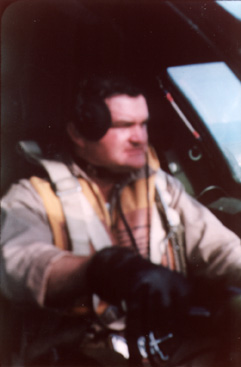 |
|||||||||||||||||||
| Unfortunately our squadron equipment, including aircraft, photo and electronic capabilities were antiquated and derelict. The RB-29s had been in the theater since the end of WW-II and suffered from extreme corrosion due to the salt air environment of the Pacific. The determination of the ground and flight crews to "AIM HI" (A USAF quality control motivational effort.) never wavered. We accomplished the impossible fighting the elements with the equipment at hand. At the excellent direction of our maintenance officer Capt. Mike Moffett and his maintenance personnel the missions were accomplished with a lot of blood, sweat, and tears, working around the clock to complete the assigned mission. |
|||||||||||||||||||
|
Photo Ctsy. Earl Myers |
|||||||||||||||||||
| My new crew was made up on Okinawa after arrival. They were a collection of crew members that were waiting for a mission assignment and some leadership. They were individually getting their 4 hours flying time in each month, as they could. We all had a lot of work to do as they were out of contact with the real world. We had a lot of hard work in front of us. Our F.E. T/Sgt Carl Bomgardner organized the enlisted crew members and got them together and then we all worked together to create a cohesive, operational crew as quickly as possible. It took a lot of hard work and we worked and played together to build up confidence and relationships with each other. We all enjoyed being on a crew and we accomplished a lot without the help of MTDs (Military Training Detachments) and special training or ground school, which were nonexistent. on Okinawa. |
|||||||||||||||||||
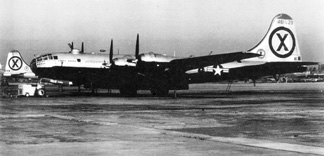 |
|||||||||||||||||||
| All crew members, ground and flight, wanted to be the best crew in the Squadron. We all would go to our assigned aircraft #1929 and clean it inside and out. It was a mess when we took it over. We scrounged paint and with the help of support personnel, like Bill Sutton "The Tin Bender," to do some patch work here and there. Our engineering officer Capt. Mike Moffet gave us all the support he could and worked with us. |
|||||||||||||||||||
|
Photo Ctsy. Earl Myers |
|||||||||||||||||||
| We started with a "bucket of bolts"' and ended up looking like a factory new aircraft, almost. We did many operational sorties in 929, 43 of them over Korea. She was a grand old girl and brought us home, every time a little more weary than before, but brought us home. 929 always "SMILED" at the flight and ground crew on return from any mission. She was a sweetheart. The ground crew and the flight crew continued to work together to complete our assigned missions in spite of almost insurmountable odds.
One of our first assignments involved a long range mission from Clark AB, in the Philippines. After a couple of days at Clark, to get organized, with an assortment of auxiliary bladder gas tanks in the bomb bays, we launched for an extended mission. Our route covered the entire coast of China to Manchuria, south along the west coast of North Korea to South Korea and east to the Sea of Japan, then north to the Kamchatka Peninsula and continuing north to the Kuril Islands then back south to Misawa AB, Hokkaido, Japan. The recent shoot-down of the US Navy survellience aircraft was by no means a sign that combined US intelligence efforts were plowing new ground. We have been conducting reconnaissance efforts in those territories for more than 51 years. |
|||||||||||||||||||
| On the lighter side, I had brought a copy of Frankie Lane’s new record "MULE TRAIN" with me from the States. On a Saturday evening I took it with me to the O-Club and asked them to play it. Believe me, it was a smash hit. The next day AFRS (Armed Forces Radio) broadcast several announcements trying to locate the guy who had the record "Mule Train." They said “Please call.” I did and ended up loaning them the record so they could make a tape copy. One day, soon after, they played it for 24 hours without a break. Bob McCulley, my hut-mate, and I, had a loudspeaker system that we had scrounged somewhere hooked up on the roof of our quarters. |
|||||||||||||||||||
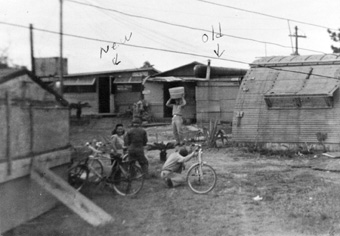 |
|||||||||||||||||||
|
Bob McCully and Earl Myers were residents of “This Castle on the Hill. ” The original structure is under the “old” arrow. They added a living room to the two bedroom shack ( see under the “new” arrow). They had a “local” dig a septic tank. Their water was solar-heated, on the roof. That is Earl, carrying a tub of water on his head. Photo Ctsy. Earl Myers. |
|||||||||||||||||||
| It was set to come on at about 0630 hrs every morning to get the guys out and moving for an 0800 hrs roll call. There was an Afro-American engineers outfit that came marching by about 0700 hrs every morning enroute to the mess hall. They heard the music once and came by the following morning and did a whirligig marching formation in front of our quarters that was a sight to behold. It is a shame that it was not filmed for posterity.
|
|||||||||||||||||||
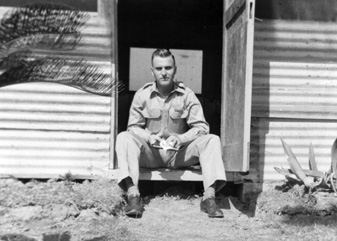 |
|||||||||||||||||||
|
cleaning his 45 cal pistol. Photo Ctsy. Earl Myers |
|||||||||||||||||||
| In late 1949 Kadena Air Base and the island of Okinawa was visited by Typhoon Gloria. That was truly an amazing experience as we worked together to save our aircraft, maintenance facilities and our community support system. Although I believe the wise command decision should have been to evacuate the aircraft, we were directed to hold our ground, in place. The CO had us man the aircraft with engines running, flaps up, facing into the hurricane force winds. We had a full load of fuel for added gross weight. The entire crew was on board in their positions. We survived, but some of the smaller aircraft bit the dust in the process. The local administrative aircraft, including a C-45, AT-6 and L-5 were all wrecked. The local C-47 was away on a trip to Clark Air Base in the Philippines and survived, as did the B-17 that was RONed at a destination I cannot recall. |
|||||||||||||||||||
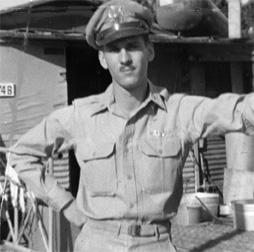 |
|||||||||||||||||||
|
Earl and Bob put a divider between them, in the middle of the room, and enclosed it for privacy. They shared a closet that had an opening on both sides. Earl says, Mac was a damn good pilot and room mate. He had a pearl handled six shooter and would knock off the rats at night. Photo Ctsy. Earl Myers
|
|||||||||||||||||||
| The Typhoon finished passing through on a Friday and it seemed only natural that we should celebrate our survival the following Saturday night.
The party was at the Officer’s Club, sponsored by the 31st SRS. Dress code was anything goes. It was a blast. I had gone to the RYCOM Mortuary and obtained some empty bottles of arterial cleansing fluid and some embalming fluid bottles and washed and steamed them clean. I poured Scotch and Bourbon in two of them and Vodka and Gin in the other two. I sat them on our party table where our group was gathered as we consumed a drink or two or three. I had the label's covered with something that I don't remember at the present. After they were about 1/4 or 1/2 consumed I uncovered the real labels and MAN was I in trouble. The guys really gave me a hard time and threatened to throw me off the porch and cliff behind the O.C. Tom Coleman was the leader of that group. |
|||||||||||||||||||
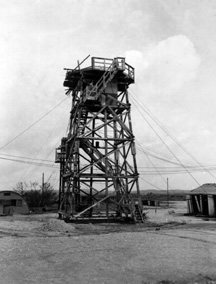 |
|||||||||||||||||||
|
|
|||||||||||||||||||
| Anyway after the party was over and all that could still navigate saw to it that I was escorted back to the shack where Bob McCully and I lived. They proceeded to douse me but good in our home-made shower. No solar heating at 0200 hours. I retaliated after all had departed for their own "quarters" by playing MULE TRAIN on our P.A. system. I was in for it again.
We all kicked that party around for a long time. Many years later, while I was in Mexico, instructing Mexican pilots in the operation of Lear Jets, I had frequent occasion to go to Tucson for special aircraft maintenance. |
|||||||||||||||||||
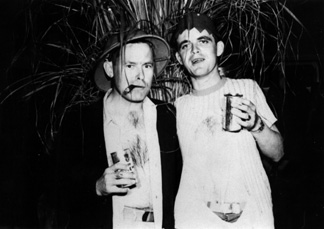 |
|||||||||||||||||||
|
|
|||||||||||||||||||
|
Tom lived in Tucson and I had the chance to visit with with him a number of times. We always had many fond memories to share. We first meet in Ft. Worth while assigned to the 7th Bomb Wing in 1947. Tom Coleman is deceased and is interned in Riverside, Ca. at the National Cemetery.
|
|||||||||||||||||||
| In late May, 1950, the 31st Recon Sq. conducted an Operational Readiness Test, flying out of Kadena AFB Okinawa. Immediately upon completion of the ORT, most of the squadron’s RB-29s (eight, as I recall) were flown back to the States, to Tinker AFB, OK, for complete overhaul.
Our crew was in the states and on leave when the Korean War broke out. We had departed Oki for Guam as our first stop. We encountered unforcasted winds that complicated and delayed our arrival. [The details of this experience are described in the story on this web site by Adrian Swain, our copilot.] |
|||||||||||||||||||
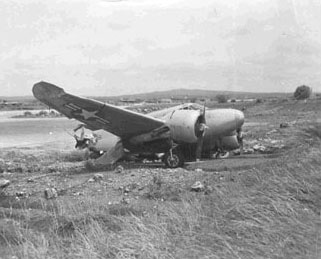 |
|||||||||||||||||||
|
Photo Ctsy. Bill Sutton |
|||||||||||||||||||
| Our refueling stops enroute were to e Kwajalein; Hickam AB, Hawaii; Firfield Susiun AB, CA; and finally on to Tinker AB, OK, where they would accomplish the repair and modifications to the aircraft.
Between Kwaj and Hickam our number #3 engine swallowed a valve, requiring a shut-down of that engine. We limped in on three and, with the leadership of our outstanding Flight Engineer, Carl Bomgardner, we did the repairs ourselves and found time to spend an extra day taking in the sights and again enjoyed the food and hospitality of Mama Mias Italian Restaurant Our flight to Fairfield Suisun was accomplished in 10 hours and 40 minutes. Being eager to get on with things, we refueled and departed for Tinker, via a direct route, as soon as we could take care of the necessary details. The departure and climb-out was uneventful. We set the autopilot for a comfortable cruise to Tinker and then crew fatigue really caught up with us. The next thing we knew we were looking out over Great Salt Lake and found ourselves about 300 miles north of course. This was in the days before radar tracking, Thank God! We got squared away with Military Flight Service, corrected our heading, and cruised on to Tinker, everyone relatively wide awake. We logged 58 total hours flying time on the trip from Oki to Tinker. On arrival, we wrote up the “squawks” on the airplane Form One. The crew was cleared to disperse and carry out their individual home visit plans. Before we parted, we had agreed upon an alerting system for emergency contact with all crew members. Little did we know that it would be activated in just 2 days time. Finishing with the aircraft delivery formalities, I went to the OKC commercial airport and flew to Omaha, then took the Union Pacific to Grand Island, NE, where my wife and 3 year old son, Steve, were with her mother. After two days in Grand Island, the news broke about the Korean Police Action. I called my previous Carswell Sq. Commander, Col. Bill Savoie, who was now in the Director of Operations Office at SAC Hdqs. and asked him for instructions. We were originally scheduled to return by MATS from Travis. Col. Savoie advised me to proceed to McClellen AFB, Sacramento and pick up RB-29 #1815 and return to Kadena ASAP. He said our orders would be waiting at McClellend. He asked if I could collect my crew and I told him of our telephone chain locating plan. He told me to “pull the chain” and get on with it! After having had two days in Grand Island, I departed by Union Pacific train to Omaha and by United Airlines to San Francisco, and then a rent-a-car to Sacramento/McClellen. The RB-29 that we were to pick up was ready for a functional flight check on my arrival and my flight engineer, Carl Bomgardner, and tail gunner, Ervin Brooks, were there. The three of us joined the depot civilian crew to accomplish a quick test flight. I served as the co-pilot and Carl as F.E. along with the civilian crew. The test hop was completed with a few squawks that were quickly corrected. The Navigator, Cass Casserly, and radio operator, Paschall, had arrived. By this time it was about 2 a.m. We hit the sack and were back at the aircraft at 0900hrs. All squawks were closed and we were advised to fly over to Hamilton Field for over-water gear and then proceed to Travis for overseas briefing. The remaining crew showed up at Travis. While at Hamilton we went to lunch at the Officers Club while the life rafts were being installed. On entry to the club, there was a lady who was the Guest Activities Director who assisted visiting officer's to visit some of the local attractions in San Francisco — The Redwoods National Park etc. I noticed her name on her desk. It said Mrs. Genie Bobzine. I asked her if she had been located at Moody Field, Ga., Mother Moodys Rest Camp? She replied, yes, my husband was Wing Commander there. I explained to her that Col. Bobzine had pinned my wings on just 4 years earlier. We had lunch together and talked about old times at Moody. I told her about Col. Bobzine’s kindness to me when my Grandmother was not expected to live just 10 days before graduation. How he had set up a B-25 and a training flight to Kansas City with me at the controls, dropped me off, then picked me up on Monday morning to return to Moody. We both shed some tears and offered a prayer for Col. Bobzine who was deceased. Now on to Travis. We just knew that we would get some crew rest. A refueling truck pulled up as we parked and a clearance was handed us by The Task Force officer. He told us our destination was Hickam. He didn't even say adios or wave to us. He did expedite our aircraft out to the T.O. end of the runway. Our reaction to the Korean War being in progress was not even discussed. We wanted to return ASAP, and we did. Our routing was from Hickam to Kwaj and then to Kadena, Okinawa. About 200 miles out, radio contact was established with Okinawa Control and we were asked our fuel status. I made the mistake of telling them the truth. Our destination was changed to Yokota. The landing a Yokota was uneventful except for a complete crew of Sad Sacks lacking crew rest. So it goes! We had about 36 hours on the ground before our first scheduled combat mission. |
|||||||||||||||||||
|
Editor’s Note This web site contains a number of stories relating to Earl Myers’ and related experiences while stationed at Kadena AB, Okinawa and, later at Yokota AB, Japan. Rather than repeat them here, we offer a selection of links that will take you to the individual stories and then back to Earl’s biographical narrative. The selections below include comments and images relating to the Okinawan experience, leading up to the breakout of the Korean War. See “Contributed Okinawan Images and Notations” See “Jets Shoot Down Crippled B-29 in China Sea after Crew Jumps”
Go to EEM Introduction —Chapter 1 — 2 — 3 — 4 — 5 — 6 — 7 — 8 |
|||||||||||||||||||